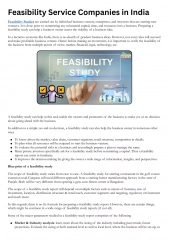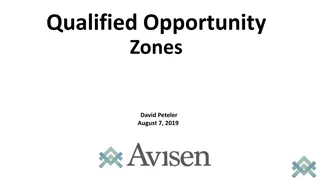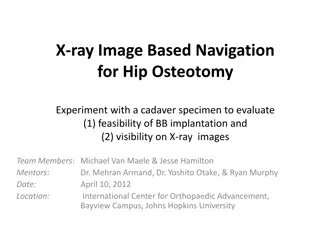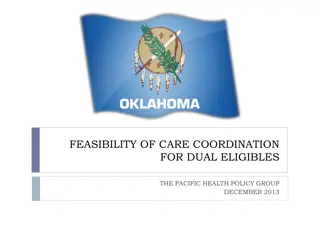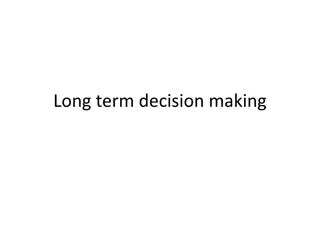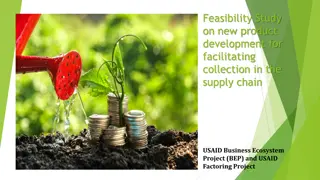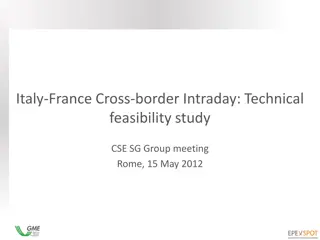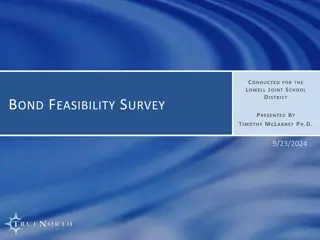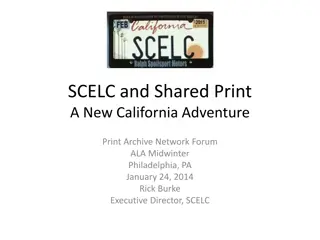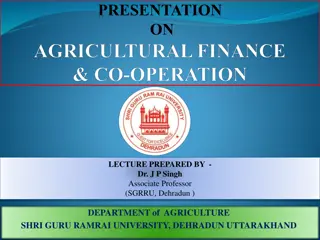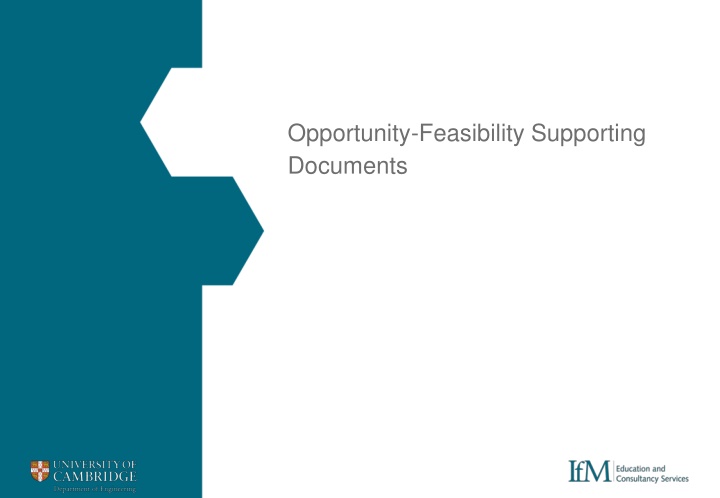
Selecting Factors for Opportunity and Feasibility Analysis
Explore in-depth the factors to consider for opportunity and feasibility analysis in business decision-making. Learn about selecting factors, scaling statements, scoring processes, and understanding results to make informed choices. Dive into detailed examples of opportunity and feasibility factors to enhance your strategic planning.
Download Presentation

Please find below an Image/Link to download the presentation.
The content on the website is provided AS IS for your information and personal use only. It may not be sold, licensed, or shared on other websites without obtaining consent from the author. If you encounter any issues during the download, it is possible that the publisher has removed the file from their server.
You are allowed to download the files provided on this website for personal or commercial use, subject to the condition that they are used lawfully. All files are the property of their respective owners.
The content on the website is provided AS IS for your information and personal use only. It may not be sold, licensed, or shared on other websites without obtaining consent from the author.
E N D
Presentation Transcript
Opportunity-Feasibility Supporting Documents
Overall Process Overview Selecting factors Remember to select the factors that are appropriate for your business, the example factors on the following slides may help to generate some ideas Scaling statements The scaling statements that you choose need to be relevant to your business. There are some examples included here and a longer list in the Appendix to the paper. You can will also find a blank template in the included Excel file Scoring Follow the scoring process set out later in these slides. An outline project brief is included here, and template individual and group scoring sheets are included in the Excel file Understanding the results A reminder of what the results mean when plotted is included towards the end of these slides. There is also a template you can use to plot your own points 2
Selecting Factors Example Long List of Opportunity Factors Select ( ) Dimension Factor Explanation Volume Size of potential market, or number of potential adoptions, reasonably available to us Market size Sales potential (in a given time) Sales volume or number of adoptions anticipated in a defined time (say, 5 years) Possible additional benefits to other projects or activities; or the possibility of new opportunities in combination Synergy opportunities Identifiable benefit to customers (internal or external) or potential adopters Customer benefit Competitive intensity in market Number or significance of the competition Margin Increased margin or benefit per unit Improvement in project margin (e.g. by cost reduction or price premium) compared to existing products; or benefit to us per adoption Business cost reduction or simplification Contributes to cost reduction or simplification of business process Industry / market readiness How easy will it be for customers or adopters to take up the product; do they have to change their behaviour or processes? Platform for future growth Market growth Anticipated growth rate of market Product is a platform for future products or could open new applications or markets in future Future potential Intangibles Learning potential Will it improve knowledge or competence in the business Brand image Effect on image of the company with investors, customers or other stakeholders Impact on key customer relations Importance for relations with key customers Source: Mitchell et al. 2014
Selecting Factors Example Long List of Feasibility Factors Select ( ) Dimension Factor Explanation Characteristics of the product How well the product is differentiated from those of major competitors Differentiation Sustainability of competitive advantage Our ability to sustain our competitive position (e.g. IPR, brand strength, etc.) How confident are we that the proposed product is technically feasible? Technical certainty Capability Our understanding of size and requirements of the market Market knowledge Do we have the required technical competence to develop the product? Technical capability Supporting business processes Fit to sales and/or distribution Fit to our sales competences and/or distribution chain Fit to manufacturing and/or supply chain Ability to manufacture or supply the product Availability of finance for the project Finance Organisational backing Strategic fit How well does the proposal fit our company strategy? Level of staff or management backing at an appropriate level Organisational backing
Scaling Statements Examples for Opportunity Factor 0 2 4 6 8 Market size < 5,000 units 25,000 units 50,000 units 100,000 units 200,000 units Sales potential in a given time > 1,000 units in 5 years (gross margin 300k) 3000 units in 5 years (Gross margin 1M) 10,000 units in 5 years (Gross margin 3M) 20,000 units in 5 years (Gross margin 6M) 50,000 units in 5 years (Gross margin 15M) Synergy opportunities None Little Will help to complete product portfolio Important A key part of a major initiative Customer benefit No obvious benefit to customers. Some benefit to some customers Clear customer benefits within existing norms; work visiting existing customers to promote A significant advance in more than one key feature of interest to customers Eye-catching new benefits; a talking point at shows; entry to competitor accounts Competitive intensity in market 4 or more strong competitors 2 strong competitors 2 strong competitors We will be alone in the market Increased margin or benefit per unit Benefit worth < 300k Benefit worth 1M Benefit worth 3M Benefit worth 6M Benefit worth 15M Market growth Stagnant market <5% per year 5-10% per year 20% per year >50%per year These are examples and you will need to select or create appropriate ones for your business. More examples exist in the Appendix to the working paper. 5
Scaling Statements Examples for Feasibility Factor 0 2 4 6 8 Product differentiation No features that are better than competition At least one feature is better than offered by the competition We have some minor features that are better than the competition At least one important feature is significantly better than the competition Several important features are much better than competition Sustainability of competitive advantage Key differentiating features will be easy to copy. Or serious concerns about IP against us We are 6-12 months ahead of the competition. No serious IPR concerns. Competitive advantage can be maintained with continuous effort We are at least 2 years ahead of the competition Key features are protected by IPR or unique capabilities that are not easy to copy Technical capability We will have to buy in new major capabilities, OR recruit a new technical team, OR rely on a partner We will have to buy in new major capabilities, OR recruit a new technical team, OR rely on a partner Existing staff can acquire capabilities in 3 months or less, or by recruiting one or two new people Some new skills required but they can be acquired in time. Some new skills required but they can be acquired in time. Fit to sales and/or distribution Entirely new distribution channel required. OR requires new sales skills that at least half the sales force will struggle with Changes to sales or distribution will need special attention >75% of sales force could sell it with training or >75% of existing distribution applicable Some changes to sales or distribution but within our capabilities in the time Some changes to sales or distribution but within our capabilities in the time These are examples and you will need to select or create appropriate ones for your business. More examples exist in the Appendix to the working paper. 6
Scoring - Outline of the Scoring Process Select reviewing teams Reject any projects outside range Prepare and review project briefs Preparation Individual scoring (record key assumptions) Collate individual scores and assumptions Scoring Reject any below standard Group review Display ranges on opportunity- feasibility diagram Decisions Prune low value projects Review portfolio Reject any below standard 7
Scoring - Project Outline Brief Project Name Project Owner XXXX XXXXX Brief description of project Lorem ipsum dolor sit amet, consectetur adipiscing elit, sed do eiusmod tempor incididunt ut labore et dolore magna aliqua. Ut enim ad minim veniam, quis nostrud exercitation ullamco laboris nisi ut aliquip ex ea commodo consequat. Duis aute irure dolor in reprehenderit in voluptate velit esse cillum dolore eu fugiat nulla pariatur. Excepteur sint occaecat cupidatat non proident, sunt in culpa qui officia deserunt mollit anim id est laborum. Lorem ipsum dolor sit amet, consectetur adipiscing elit, sed do eiusmod tempor incididunt ut labore et dolore magna aliqua. Ut enim ad minim veniam, quis nostrud exercitation ullamco laboris nisi ut aliquip ex ea commodo consequat. Duis aute irure dolor in reprehenderit in voluptate velit esse cillum dolore eu fugiat nulla pariatur. Excepteur sint occaecat cupidatat non proident, sunt in culpa qui officia deserunt mollit anim id est laborum." Key considerations (Possible value, Resource use, relevance to other projects, critical factors etc) Lorem ipsum dolor sit amet, consectetur adipiscing elit, sed do eiusmod tempor incididunt ut labore Lorem ipsum dolor sit amet, consectetur adipiscing elit, sed do eiusmod tempor incididunt ut labore Lorem ipsum dolor sit amet, consectetur adipiscing elit, sed do eiusmod tempor incididunt ut labore Lorem ipsum dolor sit amet, consectetur adipiscing elit, sed do eiusmod tempor incididunt ut labore Lorem ipsum dolor sit amet, consectetur adipiscing elit, sed do eiusmod tempor incididunt ut labore 8
Understanding the Results - Overview of Outcomes Consider long term Pursue now Projects bottom left to top right may need more research Opportunity Consider if enabling Abandon Feasibility 9
Understanding the Results - Sample Opportunity x Feasibility Chart 8 4 Opportunity 0 4 8 Feasibility 10

